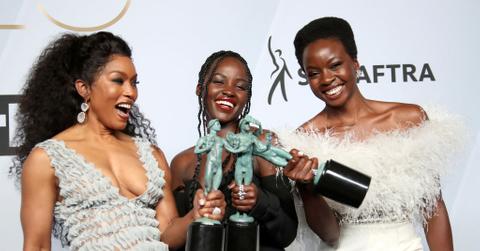
The Fashion Influence of the ‘Black Panther’ Cast
By Alan BlakeDec. 18 2023, Published 10:23 p.m. ET
There’s no denying that cinema impacts society by shaping beliefs, behaviors, and opinions. Black Panther was no different, but it was one of a kind, featuring melanated global actors such as Chadwick Bossman, Lupita Nyong’o, and Angela Bassett. Consequently, It’s not hard to see why audiences across the globe widely anticipated Black Panther’s premiere. It marked a milestone of significant cultural progress, optimism, and a unique fashion craze. The film grossed $1.3 billion worldwide in 2018 and was the highest-grossing film of that year in the United States. It is also crystal clear why and how Black Panther and subsequently its sequel, Black Panther: Wakanda Forever, put Africa’s fashion on a global stage. Here are more details on the Black Panther's fashion influence on fans.
‘Black Panther’ Costumes Relied On Real African Influences
Following the release of Black Panther and Black Panther: Wakanda Forever, it was evident that the film’s costume designer, Ruth E. Carter, understood the assignment. Although the films are a work of fiction, the costume designer sought influence from authentic African fashion to fully and accurately depict the African theme.
“We created lots of mood boards that showed you the different indigenous tribes and what that look like,” Ruth told NPR. “There's thousands of tribes throughout the continent of Africa, and we picked eight or 12 of them to represent the tribes of Wakanda.”
The protagonist, Chadwick Boseman, wore a deep black suit to depict a black panther. At the same time, Angela Bassett’s stunning and elegant headpiece can be traced back to Zulu culture in South Africa. Danai Gurira's team also wore bead necklaces, metal bangles, and fabric inspired by the Maasai tribe in Kenya and Tanzania.
It is hard to miss the bald heads, a phenomenon common among the Maasai people. Again, Danai’s crew wore neckrings that were inspired by the Ndebele tribe of South Africa.
Keen watchers may have noticed that Lupita Nyong’o wore exotic fabrics in a unique red, green and black blend. The unique blend of colors represents the Pan-African flag and colors that are featured on most African countries’ flags.
Daniel Kaluuya, on the other hand, donned the Basotho blanket, which has immense cultural significance among the people of Lesotho. He also had facial scarification, which was shared across multiple tribes, such as the Dinka and Nuer of Sudan. Winston Duke's attire was inspired by the ancient tribe of Dogon, whose warriors would wear grass skirts when heading to a battle.
The Workings Behind ‘Black Panther’s Costumes
Ruth E. Carter had before cemented her status as a luminary costume designer. However, it is through Black Panther that she made a mark globally, by fusing clothes from different African countries to create the unique pieces donned by the cast of the legendary Wakanda film.
According to The New York Times, Ruth was so dedicated to sourcing the best materials for all cast members that she sent scouts across Africa and researched widely about individual cultures of the African continent.
Since Wakanda was an imagination of the African continent untouched by white invasion, Ruth was determined to depict it as director Ryan Coogler described it. She took the time to inspect the history of every piece of artwork, fabric, necklace, and bracelet that would feature in the film.
‘Black Panther’s Fashion Is A Cultural Masterpiece
Black Panther did a great job of positively representing culture, gender, and race. One of the most outstanding ways it did was through the film’s fashion inspired by traditional and contemporary African culture.

